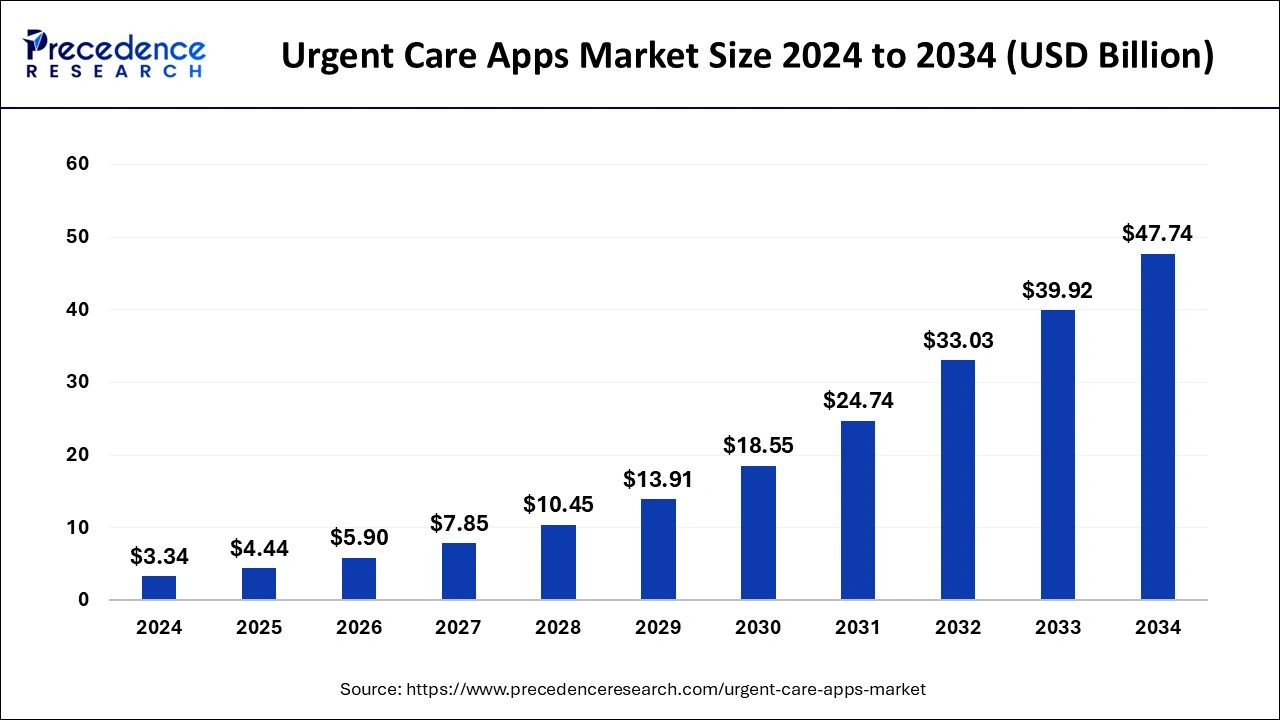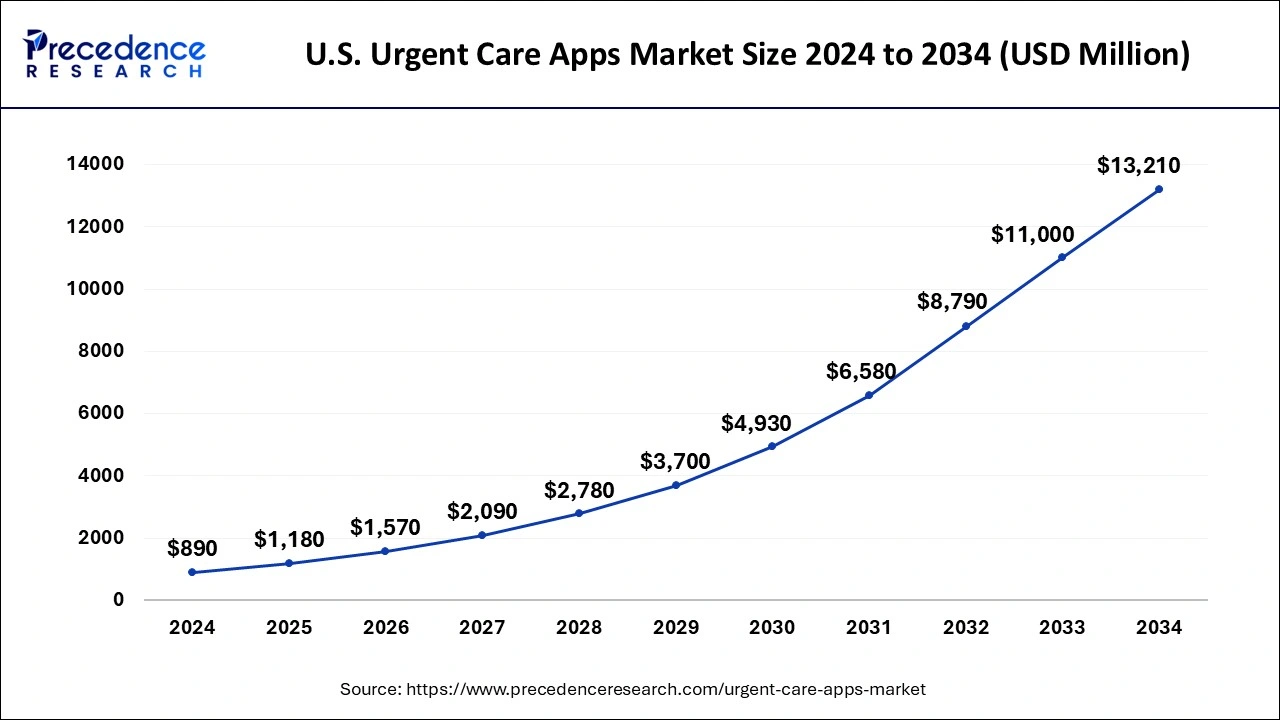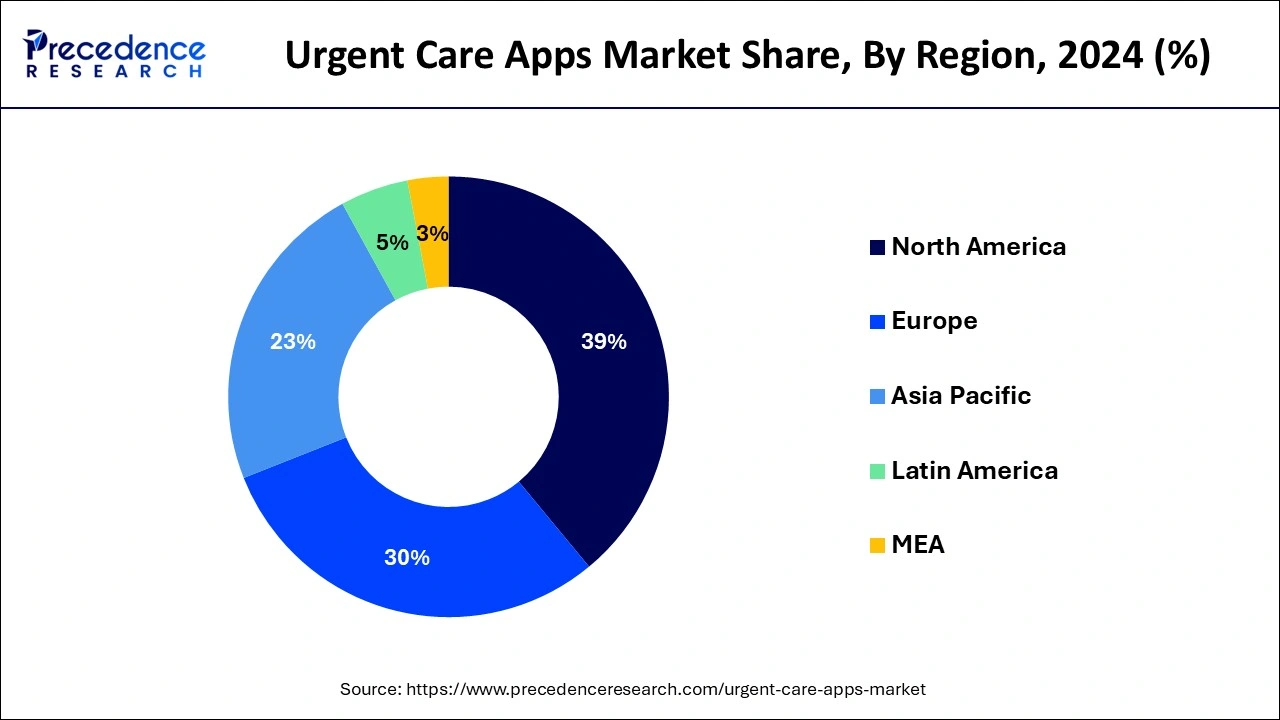February 2025
The global urgent care apps market size is evaluated at USD 4.44 billion in 2025 and is forecasted to hit around USD 47.74 billion by 2034, growing at a CAGR of 30.47% from 2025 to 2034. The North America market size was accounted at USD 1.30 billion in 2024 and is expanding at a CAGR of 30.50% during the forecast period. The market sizing and forecasts are revenue-based (USD Million/Billion), with 2024 as the base year.
The global urgent care apps market size accounted for USD 3.34 billion in 2024 and is predicted to increase from USD 4.44 billion in 2025 to approximately USD 47.74 billion by 2034, expanding at a CAGR of 30.47% from 2025 to 2034.

The U.S. urgent care apps market size was evaluated at USD 890 million in 2024 and is projected to be worth around USD 13,210 million by 2034, growing at a CAGR of 30.96% from 2025 to 2034.

North America held the largest revenue share of 39% in 2024. North America has one of the highest rates of smartphone adoption globally. The widespread use of smartphones provides a robust platform for the adoption of urgent care apps, as users can easily access healthcare services through mobile devices. It has seen a rapid integration of telemedicine, with urgent care apps playing a crucial role in facilitating remote consultations. The COVID-19 pandemic further accelerated the acceptance of telehealth solutions, contributing to the growth of urgent care apps.
Asia-Pacific is estimated to observe the fastest expansion. Asia-Pacific encompasses diverse healthcare systems, from highly developed ones to emerging markets. This diversity influences the strategies and features adopted by urgent care apps to cater to the specific needs of each market. Moreover, there is an increasing awareness of the benefits of telehealth and telemedicine in Asia-Pacific. Urgent care apps play a crucial role in providing convenient and accessible healthcare services, especially in areas with limited access to traditional healthcare facilities.
The Europe urgent care apps market has been experiencing growth in response to the increasing demand for convenient and accessible healthcare services. European countries have been actively embracing digital health solutions, and urgent care apps are no exception. The shift toward digital health is driven by factors such as the need for remote healthcare services, advancements in technology, and a growing awareness of the benefits of telemedicine. Europe has a high penetration of mobile technology, with a significant percentage of the population using smartphones. This prevalence of mobile devices provides a conducive environment for the adoption of urgent care apps, making healthcare services more accessible to a broader demographic.

Urgent care apps are mobile applications designed to provide immediate medical assistance, information, or services to users. The apps are typically focused on offering quick access to healthcare resources, especially in situations that may require urgent attention but may not necessarily warrant a visit to the emergency room. Moreover, some apps facilitate the renewal of prescriptions, allowing users to request medications through the app. It also provides guidance on handling medical emergencies and offers information about nearby urgent care centers or hospitals. With the help of this application, users can input their symptoms, and the app provides information about potential conditions or illnesses. Users can store and access their medical history, allowing healthcare professionals to have a comprehensive view of their health.
Urgent care apps market provided with mobile applications that is designed to deliver immediate medical assistance, guidance, and information to users. The apps mainly focus on delivering urgent or immediate care services remotely, often leveraging telemedicine and digital health technologies. The urgent care apps market has seen growth due to the increasing demand for convenient and accessible healthcare services, especially outside traditional healthcare settings. Factors such as the rise of telemedicine, advancements in mobile technology, and the need for quick medical advice contribute to the expansion of this market.
| Report Coverage | Details |
| Growth Rate from 2025 to 2034 | CAGR of 30.47% |
| Market Size in 2025 | USD 4.44 Billion |
| Market Size by 2034 | USD 47.74 Billion |
| Largest Market | North America |
| Base Year | 2024 |
| Forecast Period | 2025 to 2034 |
| Segments Covered | Clinical Area and Product |
| Regions Covered | North America, Europe, Asia-Pacific, Latin America, and Middle East & Africa |
Rise in smartphone adoption
The exponential rise in smartphone adoption has become a pivotal driver behind the escalating demand for urgent care apps, revolutionizing the landscape of healthcare delivery. With smartphones becoming ubiquitous and an integral part of daily life, a vast and diverse user base now has the capability to access healthcare services conveniently through their handheld devices. This surge in smartphone ownership facilitates a broader reach for urgent care apps, democratizing healthcare access and breaking down geographical barriers.
The ubiquity of smartphones not only expands the potential user base but also aligns with the modern consumer's preference for on-the-go solutions. Urgent care apps leverage the functionalities of smartphones to offer users a seamless experience, allowing them to schedule virtual consultations, receive timely medical advice, and access healthcare resources from the comfort of their homes. This trend is particularly significant in fostering a proactive approach to healthcare, as individuals can now seek immediate medical attention or information at their fingertips, fostering a culture of preventive care. As smartphone adoption continues to rise globally, the demand for urgent care apps is poised to grow, marking a transformative shift in how healthcare services are accessed and delivered in the digital age.
Data security and privacy concerns
Data security and privacy concerns loom as potential restraints on the demand for urgent care apps, impacting user trust and adoption. As these apps handle sensitive health information, users are understandably apprehensive about the protection of their personal data. The potential for breaches or unauthorized access poses a significant challenge, as compromised health data could have serious consequences for individuals. Moreover, the regulatory landscape surrounding digital health and patient data protection is continually evolving, adding complexity and uncertainty to compliance measures for app developers.
The reluctance of users to share their health information due to privacy concerns may hinder the effectiveness of virtual consultations and limit the adoption of urgent care apps. Building and maintaining robust security measures, including encryption protocols and secure storage practices, is imperative to address these apprehensions. App developers must prioritize transparent communication about privacy policies, data handling practices, and compliance with regulations to instill confidence among users.
Efforts to establish industry standards for data security and privacy in digital health, along with stringent regulatory frameworks, are crucial to mitigate these concerns. Striking the right balance between providing convenient healthcare solutions and ensuring the utmost protection of user data is paramount for the sustained growth of the urgent care apps market in an environment increasingly scrutinized for privacy and security.
Expansion into remote patient monitoring capabilities
The strategic expansion into remote patient monitoring capabilities stands as a significant opportunity for the urgent care apps market, heralding a new era of comprehensive and proactive healthcare. By integrating remote patient monitoring features, urgent care apps can extend their utility beyond immediate consultations, allowing for continuous tracking of health metrics and conditions. This evolution aligns with the paradigm shift towards preventive healthcare, offering users the ability to monitor their well-being in real-time.
Remote patient monitoring empowers individuals to take charge of their health by providing a continuous stream of data that can aid in the early detection of potential issues. This is particularly valuable for managing chronic conditions, as healthcare professionals can remotely assess patients' vital signs and health indicators, adjusting treatment plans as needed. The seamless integration of remote patient monitoring into urgent care apps transforms them into holistic healthcare platforms, fostering ongoing engagement between users and healthcare providers.
Moreover, in the global healthcare landscape, remote patient monitoring can bridge geographical gaps, offering healthcare services to individuals in remote or underserved areas. The expansion into this capability not only enhances user experience but also positions urgent care apps as integral components of a modern, technology-driven healthcare ecosystem, contributing to improved health outcomes and a more proactive approach to wellness.
In 2024, the stroke segment had the highest market share of 39% on the basis of the clinical area. Urgent care apps specializing in cardiac conditions aim to address emergencies related to heart health. These apps may provide features such as real-time monitoring of vital signs, guidance on performing CPR, and direct access to emergency services or nearby cardiac care centers. Early detection and swift response are critical in managing cardiac emergencies.
The trauma segment is anticipated to expand at a CAGR of 35.1% over the projected period. Urgent care apps designed for trauma focus on delivering rapid assistance and guidance for injuries such as fractures, burns, and wounds. These apps may include features like first aid instructions, emergency contact information, and step-by-step guidance to manage traumatic injuries before reaching a healthcare facility.
In 2024, the in-hospital communication apps segment had the highest market share of 48% on the basis of the product. In-hospital communication apps focus on enhancing communication and coordination within healthcare facilities. These apps are designed to improve workflow efficiency, allowing healthcare providers to communicate seamlessly, share critical patient information, and coordinate emergency responses. In-hospital communication apps contribute to a more integrated and collaborative healthcare environment, reducing response times and improving patient care within the hospital setting.
The emergency care triage apps segment is anticipated to expand fastest at a CAGR of 34.2% over the projected period. Emergency care triage apps are designed to provide immediate assistance and guidance during critical situations. These apps often feature symptom checkers, first aid instructions, and real-time communication with healthcare professionals. They assist users in assessing the urgency of their medical condition, offering preliminary recommendations for action, and facilitating a streamlined process for seeking appropriate care.
By Clinical Area
By Product
By Geography
For inquiries regarding discounts, bulk purchases, or customization requests, please contact us at sales@precedenceresearch.com
No cookie-cutter, only authentic analysis – take the 1st step to become a Precedence Research client
February 2025
January 2025
January 2024
September 2024